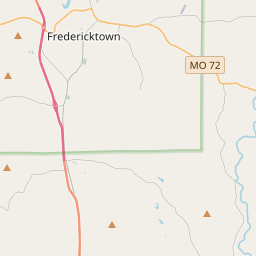St. Michael's Village
Historical marker location:
1 Court Square, Fredericktown, Missouri
( Marker is at the intersection of Court Square and West Main Street (U.S. 67) on Court Square.)
Marker installed: 1999







© OpenStreetMap contributors
300 yards north of this site. Est. 1799
Loading...
Searching for other points of interest within 3 miles of this location.Missouri was admitted to the Union as the 24th state on August 10, 1821, becoming the first state entirely west of the Mississippi River.
About Madison County
Madison County Timeline
Madison County, Missouri, has a rich and varied history that dates back centuries. The area was originally inhabited by Native American tribes, including the Osage and Shawnee, who relied on the natural resources of the region for their livelihoods. European settlement began in the early 19th century, when French explorers traversed the area. Eventually, American settlers arrived and established permanent communities throughout the county, primarily concentrated along the mineral-rich St. Francis River.
The county was officially established in 1818 and was named after President James Madison. In the early years, Madison County was primarily an agricultural community, with farming and timber industries driving its economy. However, the discovery of lead in the region in the late 19th century led to a mining boom, attracting miners and speculators to the area. Lead mining became a crucial industry in Madison County, sustaining the local economy for many years.
Throughout the years, Madison County experienced both growth and decline. The onset of the Great Depression in the 1930s, coupled with a decrease in demand for lead, led to a decline in the county's mining industry. However, the region's natural beauty and recreational opportunities began to attract tourists, leading to the development of the tourism industry as a significant source of revenue.
Today, Madison County continues to be a picturesque destination known for its natural beauty, outdoor activities, and historic sites. It is home to the Mark Twain National Forest and several state parks, offering ample opportunities for hiking, camping, and fishing. The county's rich history and charming small towns also make it an attractive place to visit for history enthusiasts.
The county was officially established in 1818 and was named after President James Madison. In the early years, Madison County was primarily an agricultural community, with farming and timber industries driving its economy. However, the discovery of lead in the region in the late 19th century led to a mining boom, attracting miners and speculators to the area. Lead mining became a crucial industry in Madison County, sustaining the local economy for many years.
Throughout the years, Madison County experienced both growth and decline. The onset of the Great Depression in the 1930s, coupled with a decrease in demand for lead, led to a decline in the county's mining industry. However, the region's natural beauty and recreational opportunities began to attract tourists, leading to the development of the tourism industry as a significant source of revenue.
Today, Madison County continues to be a picturesque destination known for its natural beauty, outdoor activities, and historic sites. It is home to the Mark Twain National Forest and several state parks, offering ample opportunities for hiking, camping, and fishing. The county's rich history and charming small towns also make it an attractive place to visit for history enthusiasts.
Madison County Timeline
This timeline provides a concise overview of the key events in the history of Madison County, Missouri.
- 1818: Madison County is officially established.
- Early 1800s: The area is inhabited by Shawnee and other Native American tribes.
- 1819: A permanent settlement is established by European-American settlers.
- 1823: Fredericktown, the county seat, is platted.
- 1861-1865: Madison County residents participate in the American Civil War.
- Late 1800s: Lead mining becomes an important industry in the area.
- 1902: The St. Joe Lead Company begins operations in Mine La Motte.
- 1924: The Ozark National Forest is established, including parts of Madison County.
- 1930s: The Civilian Conservation Corps (CCC) constructs many recreational facilities in the area.
- 1960s-1970s: Madison County experiences a decline in population due to the decline of the lead mining industry.
- Present: Madison County is known for its natural beauty, outdoor recreational opportunities, and historic sites.